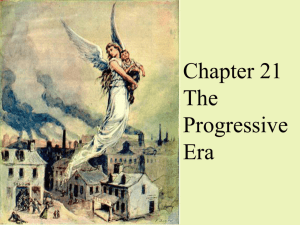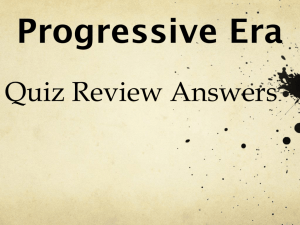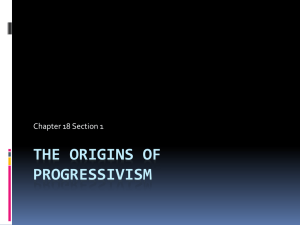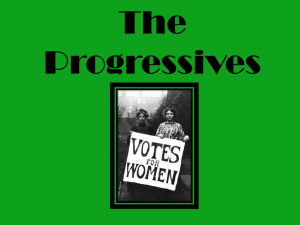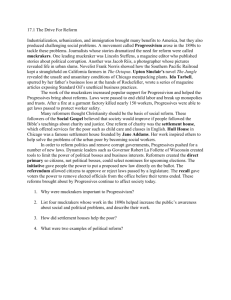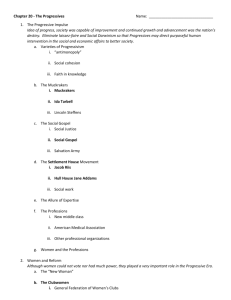The Progressive Era
advertisement
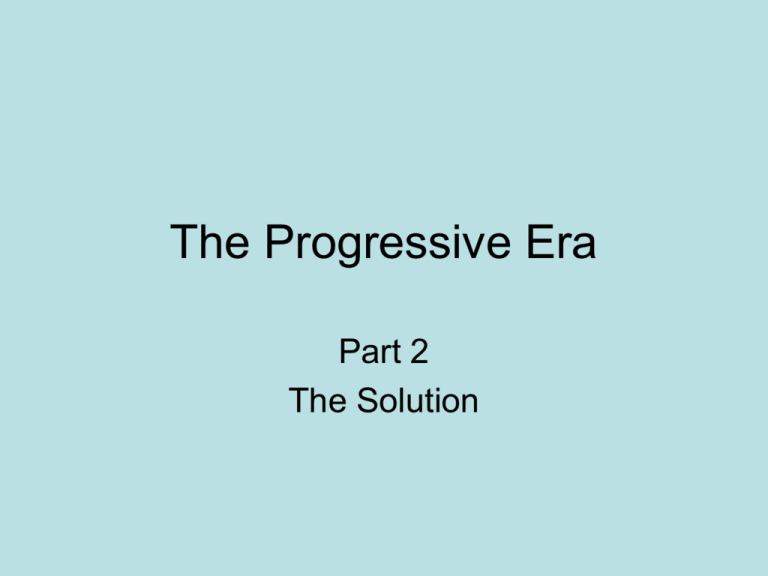
The Progressive Era Part 2 The Solution • What were settlement houses? • What was the “Social Gospel” and who was its leading voice? • Who were the “Muckrakers”? • Who were the Progressives? • Why did the Progressives want to reform society? Progressivism = New Way of Thinking • Believe that government can be a positive force in helping people. • Public good is more important than what is good for the individual. Political Reform • At the turn of the century, politicians seemed to be controlled by both big business and the political machine bosses. • Big business gave politicians $ and the bosses got to decide who the candidates would be. • Therefore, many politicians did what the bosses and big business wanted rather than what was best for everybody. • WHAT ARE SOME WAYS THAT YOU Could FIX THIS? Wisconsin Leads the Way • Wisconsin's Robert “Fighting Bob” La Follette was the leading Progressive Governor of the Progressive era. • Wisconsin is called the “Laboratory of progressivism.” Progressive Political Reforms • 1. Direct Primary —voters get to vote on who the candidates will be (rather than the bosses picking them). • 2. Initiative —regular people can introduce a bill and then the state legislatures vote on it. • 3. Referendum —voters vote on bills. • 4. Recall —voters can remove elected officials. • 5. Secret Ballots Tom Johnson • Progressive mayor of Cleveland • Regulated the streetcars. • Progressives called for government to regulate business. Calif. Progs • Hiram Johnson • Gov. of Calif. (1910-1916) • Senator from CA (1917-1945) • Prog. VP candidate in 1912. Changing the Senate • Originally, the State legislatures chose the 2 Senators from each state. • Therefore, the big bosses usually got to decide who the Senators were and they had great influence over them. • The Progressive called for the direct election of Senators (therefore the voters—the people—and not the bosses or big business, would control the Senators). • The 17th Amendment made the direct election of Senators law. Change in city govts. • Galveston flood 1900 • Killed 6,000 and left the city flooded. • City govt. was unable to deal with the disaster. • Led to development of the commissioner system of city govt. • Soon other cities followed suit. Review • Who were the Progressives? What did they want to do and why? • Who were the muckrakers? • What were settlement houses and what was the most famous one? • Who were nativists? • What state was referred to as the “laboratory” for progressivism? More Review • Why did the Progs. Think it was necessary to enact political reforms? • What were some of the political reforms enacted by progressives? • What did the 17th Amendment of the Constitution do? • What was the political impact of the Galveston flood? Women as Progressives • Women very active in reform. • Outlet into public life. Suffragettes • = Women who want the vote Lading Progressive Era Suffragettes • Carrie Chapman Catt —leader of National American Woman’s Suffrage Association (NAWSA). Used referendum process to try to get women the right to vote in individual states. • Alice Paul —National Woman’s Party (NWP). More radical. Staged protests, marches, hunger strikes and picketed the White House. What were arguments for and against? • Against = “Separate Spheres.” Will be injurious to women. • For: a) women will bring unique sensibilities to politics. Will help bring reform. • B) Why not women if blacks and immigrants and poor men? Women’s Suffrage • In 1890, women could vote in only 19 states (and then only in local or state elections). Only in Utah and Wyoming could women vote in national elections. • By 1912, 9 states (all west of the Mississippi) allowed women to vote in all elections. • In 1920, the 19th Amendment was passed that allowed women throughout the country to vote in all elections. Protecting Consumers • Pure Food and Drug Act • Meat Inspection Act Florence Kelley • Helped to create the National Consumers League (NCL). • Labeled products made in safe workplaces. • Also created National Child Labor Committee which sought to end child labor. Social Reform Public Schools—During the lat e 1800s, many states began passing laws requiring children to go to school. Before the Civil War, there were very few high schools. By 1920, there were 14,000. The illiteracy rate dropped from 20% in 1870 to 6% in 1920. Temperance • Temperance = Trying to make alcohol illegal. • Women’s Christian Temperance Union (WTCU) was the main group. • Eventually Progs. Pass the 18th Amendment which made it illegal to make, sell or transport alcohol (called prohibition). Birth Control • During the Progressive Era, there was an effort by many reformers to educate women about birth control. • This, of course, met with much opposition. • Margaret Sanger was the leading spokesperson. • Under New York’s Comstock Act, talking about birth control was considered obscene. • Sanger was arrested but the charges were eventually dropped. Immigration Restriction • Onslaught of “new Immigrants” was creating social problems. • Some Progs. sought to help (settlement houses, etc.). • Others called for laws limiting immigration. • Based on social Darwinism . • Called for quotas based on nationality. Review of Progressive Amendments • 16th = Direct Income Tax. • 17th = Direct Election of Senators. • 18th = Prohibition of alcohol. • 19th = Women get right to Vote. Review • What were settlement houses? • What was the “Social Gospel” and who was its leading voice? • Who were the “Muckrakers”? • Who were the Progressives? • Why did the Progressives want to reform society? • What were the Progressive amendments to the Constitution? • Explain how the Progs. Were divided over the issue of immigration? Regulating Business • Clayton Antitrust Act (1914)
